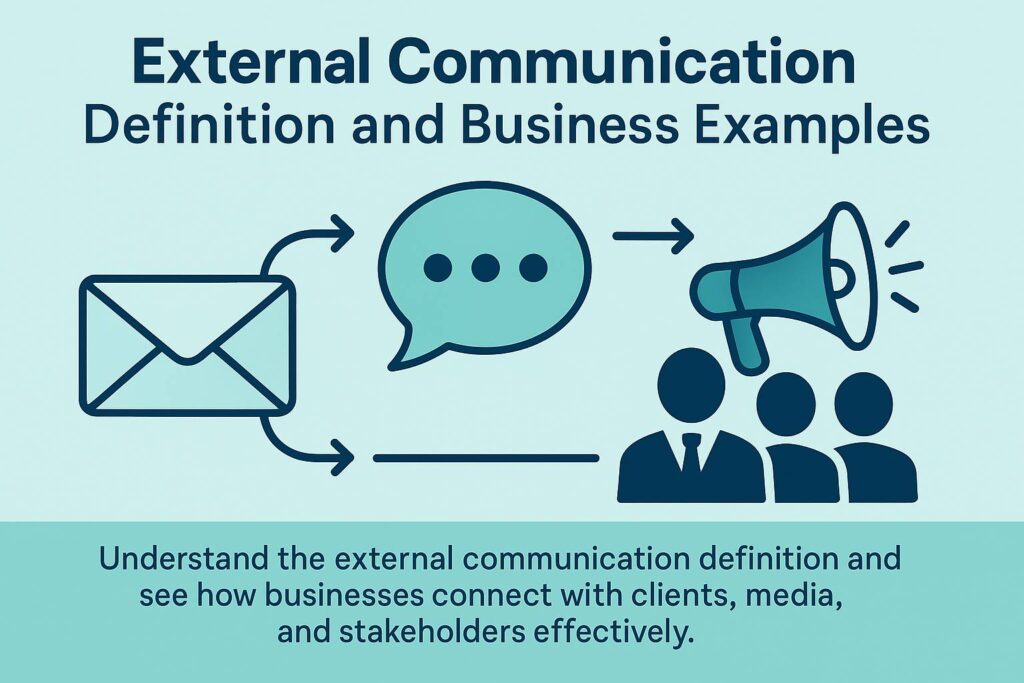
Emma Hayes
June 14, 2025
No Comments
Understanding External Communication in Business
External communication refers to the exchange of information between an organization and entities outside its boundaries, such as customers, suppliers, investors, and the general public. This form of communication is pivotal in shaping public perception, building brand identity, and fostering relationships that drive business success.
In the realm of business, external communication encompasses various channels and methods, including press releases, social media interactions, advertising campaigns, and customer service engagements. For instance, a company announcing a new product launch through a press release is engaging in external communication. Similarly, responding to customer inquiries on social media platforms also falls under this category.
Effective external communication ensures that the organization’s message is consistent, clear, and aligned with its values and objectives. It plays a crucial role in managing the company’s reputation, attracting potential clients, and maintaining transparency with stakeholders.
To delve deeper into strategies that enhance business growth through communication, consider exploring our Corporate Communication Strategy for Business Growth.
Table of Contents
Key Components of External Communication
External communication comprises several key components that collectively contribute to a company’s public image and stakeholder relationships.
Public Relations (PR): PR involves managing the dissemination of information between the organization and the public. It includes activities like press conferences, media interviews, and community engagement initiatives.
Marketing Communications: This encompasses advertising, promotional campaigns, and branding efforts aimed at informing and persuading potential customers.
Customer Service: Interactions with customers through various channels, such as call centers, emails, and social media, are vital for addressing concerns and building loyalty.
Investor Relations: Communicating financial performance and strategic plans to investors and analysts helps in maintaining transparency and trust.
Each component requires a tailored approach to effectively convey messages and achieve desired outcomes. For instance, while marketing communications focus on promoting products, investor relations emphasize financial transparency and performance.
To enhance your business English skills and effectively engage in these components, consider our English for Everyone Business English Learning Guide.
Additionally, for personalized English learning experiences, you might explore Learn English with online English teacher.
Real-World Examples of External Communication
Understanding external communication is enriched by examining real-world applications:
Press Releases: Companies often issue press releases to announce new products, partnerships, or significant milestones. For example, a tech firm launching a new gadget may distribute a press release detailing its features and availability.
Social Media Engagement: Brands utilize platforms like Twitter and Instagram to interact with customers, share updates, and address concerns. A prompt response to a customer’s query on Twitter can enhance the company’s reputation for customer service.
Advertising Campaigns: Through television, online ads, and billboards, companies promote their products and services to a broader audience. A successful campaign not only boosts sales but also reinforces brand identity.
Community Events: Hosting or participating in local events allows businesses to connect with the community, demonstrating corporate social responsibility and fostering goodwill.
These examples illustrate the diverse methods through which organizations engage with external audiences, each serving specific strategic objectives.
For insights on enhancing your business English communication, refer to our guide on How to Speak Business English Like a Pro.

Strategies for Effective External Communication
Implementing effective external communication strategies is essential for organizational success. Here are some key strategies:viostream.com+2cerkl.com+2joinglyph.com+2
Consistency in Messaging: Ensure that all communications align with the company’s values and objectives, providing a unified message across all channels.
Understanding the Audience: Tailor messages to resonate with the specific needs and preferences of different stakeholder groups.
Utilizing Appropriate Channels: Select communication channels that effectively reach the intended audience, whether it’s social media for younger demographics or press releases for investors.
Feedback Mechanisms: Establish channels for receiving and addressing feedback, demonstrating responsiveness and commitment to improvement.
Training and Development: Invest in training programs to enhance the communication skills of employees, ensuring they represent the company effectively.
By adopting these strategies, organizations can foster stronger relationships with external stakeholders and enhance their market presence.
For further exploration of business English communication, our Top Business Speaking Classes to Boost Your Confidence can be a valuable resource.
Challenges in External Communication
While external communication offers numerous benefits, it also presents challenges that organizations must navigate:
Cultural Differences: In global markets, cultural nuances can affect message interpretation, necessitating cultural sensitivity and adaptability.
Information Overload: With the abundance of information available, ensuring that messages capture attention and are retained by the audience is challenging.
Crisis Management: During crises, maintaining clear and transparent communication is critical to preserving trust and credibility.
Technological Barriers: Rapid technological changes require organizations to continuously adapt their communication tools and platforms.
Addressing these challenges involves proactive planning, continuous learning, and leveraging technology to facilitate effective communication.
The Role of Technology in External Communication
Technology has revolutionized external communication, offering new platforms and tools for engagement:
Social Media Platforms: Enable real-time interaction with a global audience, allowing for immediate feedback and engagement.
Email Marketing: Provides a direct channel to communicate promotions, updates, and newsletters to subscribers.
Webinars and Virtual Events: Facilitate interactive sessions with stakeholders, overcoming geographical barriers.
Customer Relationship Management (CRM) Systems: Help in managing and analyzing customer interactions, enhancing personalized communication.
Embracing these technological tools can significantly enhance the effectiveness and reach of external communication efforts.
Conclusion: Enhancing External Communication for Business Success
In conclusion, external communication is a vital component of business operations, influencing public perception, stakeholder relationships, and overall success. By understanding its definition, components, real-world applications, and strategies, organizations can effectively engage with external audiences.
Embracing technology, addressing challenges proactively, and investing in communication skills development are key to optimizing external communication. For personalized assistance in enhancing your business communication strategies, feel free to Contact Us | CorporateEnglish.biz.
Latest Blog
More on Corporate Communication

Corporate Communications Job Description and
Corporate communications job description includes internal messaging, media handling, and strategic branding roles for



Why Corporate Communications Careers Are
Corporate communications careers are in high demand as companies seek better branding, messaging, and



Choosing the Best Corporate Communication
Corporate communication solutions include digital platforms and tools that streamline internal messages and improve







